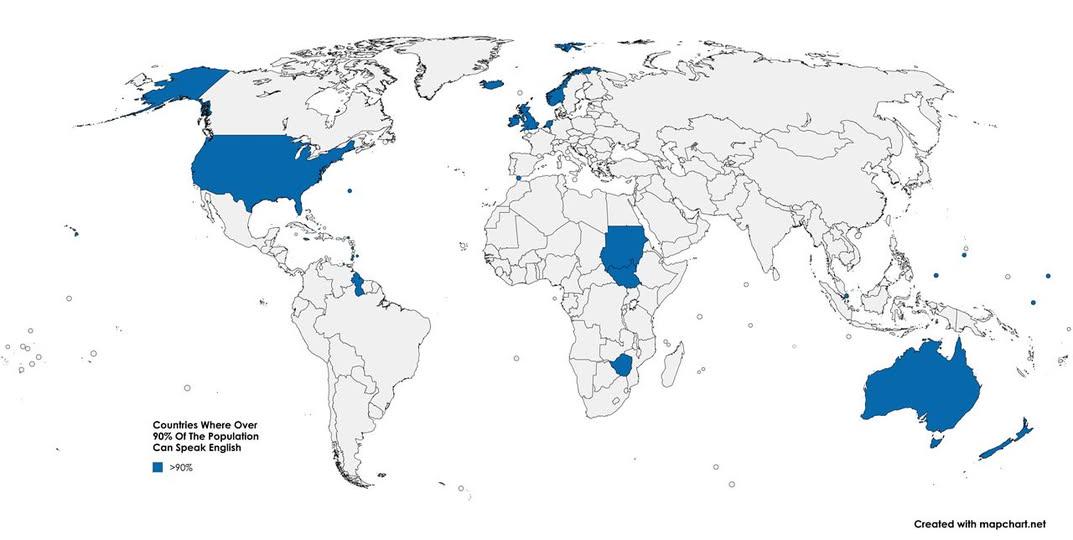Map of Countries Where Over 90% Speak English


David Chen
Data Visualization Specialist
David Chen is an expert in transforming complex geographic datasets into compelling visual narratives. He combines his background in computer science ...
Geographic Analysis
What This Map Shows
This map illustrates the countries where over 90% of the population can speak English. It highlights a significant linguistic phenomenon that reflects both historical influences and contemporary global dynamics. English, as a global lingua franca, plays a critical role in communication, trade, and cultural exchange. Understanding where English proficiency is so high provides valuable insights into the geopolitical landscape, educational systems, and cultural exchanges in these regions.
Deep Dive into English Proficiency
English has become a dominant global language over the past century, largely due to the influence of British colonialism and the economic power of the United States. Countries where over 90% of the population speaks English often share historical connections to these nations. For example, nations like the United Kingdom, Ireland, and Australia not only have English as a primary language, but it is also deeply interwoven into their cultural identity.
Interestingly, some countries in the Caribbean, such as Jamaica and Barbados, boast high English proficiency due to their colonial past, where English was established as the language of education and governance. Moreover, certain African nations, like Nigeria and Ghana, also feature significant English-speaking populations, primarily because of their colonial histories and the role of English in formal education and official communication.
It’s worth noting that English proficiency is not just about the ability to speak; it encompasses reading, writing, and comprehension. Countries with high English proficiency often have robust educational systems that emphasize English from an early age. For instance, Singapore, which is included in this map, has adopted English as one of its official languages, leading to a bilingual education system where students learn English alongside their mother tongues.
Another interesting aspect is the role that globalization plays in English proficiency. In many non-native English-speaking countries, English has become a crucial part of the economy, especially in sectors such as technology, tourism, and international business. As a result, many governments have prioritized English language training, leading to increased proficiency rates.
Regional Analysis
When we break down the map regionally, we can see distinct patterns in English proficiency. In North America, both the United States and Canada have near-total English-speaking populations, reflecting their cultural and historical ties to the English language. However, the nuances in language usage are notable; in Canada, for instance, French also plays a significant role, particularly in Quebec.
Moving to Europe, countries like the Netherlands and Sweden show impressive English proficiency, often exceeding 90%. This proficiency can be attributed to their educational systems, which prioritize English language learning from an early age. Interestingly, these countries often rank high in English as a Second Language (ESL) proficiency tests, indicating a strong emphasis on learning English as a critical skill for global engagement.
In the Caribbean, nations like Trinidad and Tobago and the Bahamas also demonstrate high English-speaking populations. The shared colonial history with British rule has left a lasting impact on the education systems, where English is the medium of instruction.
In Africa, while countries like Nigeria and Kenya have significant English-speaking populations, the dynamics are complex. English serves as an official language and is often used in government and education, but many people also speak local languages. This linguistic diversity adds richness to the cultural fabric of these nations.
Significance and Impact
Understanding where English is spoken is not just an academic exercise; it has real-world implications. In a globalized world, English proficiency can significantly impact economic opportunities, travel, and cultural exchange. For businesses looking to expand into new markets, understanding the linguistic landscape is crucial. Countries with high English proficiency often attract foreign investment, as companies seek to engage in markets where communication barriers are minimal.
Furthermore, English proficiency fosters international collaboration in various fields, including science, technology, and academia. As institutions worldwide adopt English as the medium for research and publication, countries with high English-speaking populations are often at a competitive advantage.
Looking ahead, the trend appears to be towards increasing English proficiency in non-native countries as globalization continues to influence education systems worldwide. However, it also raises questions about cultural preservation and the potential decline of local languages. Ever wondered how languages evolve in the face of such powerful global forces? The map not only highlights where English is spoken but also serves as a reminder of the intricate relationship between language, culture, and identity on a global scale.
Visualization Details
- Published
- October 31, 2025
- Views
- 12
Comments
Loading comments...